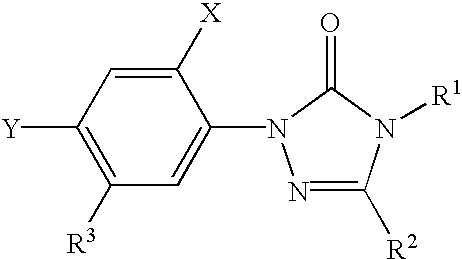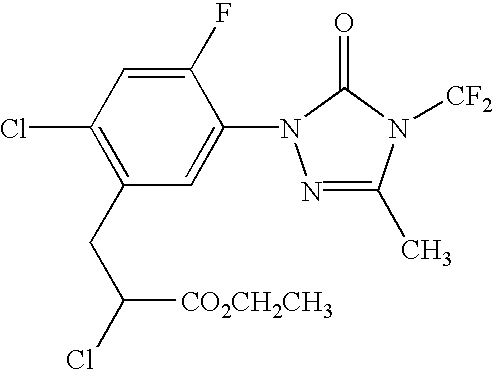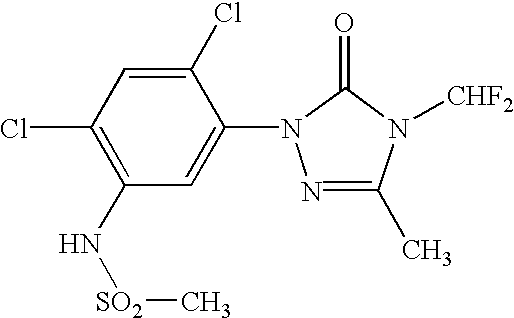Coformulation of an oil-soluble herbicide and a water-soluble herbicide
a technology of which is applied in the field of coformulation of oil-soluble herbicide and water-soluble herbicide, can solve the problems of affecting the weed control spectrum of herbicides, affecting the weed control of susceptible plants, and it takes a relatively long time (weeks or more) for susceptible plants to show the visual, etc., to achieve rapid burndown and early visual symptomology, a broader weed control spectrum, and a higher loading of herbicid
- Summary
- Abstract
- Description
- Claims
- Application Information
AI Technical Summary
Benefits of technology
Problems solved by technology
Method used
Image
Examples
example 1
[0084] A microemulsion composition was prepared having the following ingredients:
1 glyphosate IPA salt solution (MON 0139) 67.37%.sup.1 ammonium chloride 1.11% 2N hydrochloric acid 11.31% Solvent (Aromatic 150) 11.93% carfentrazone-ethyl (91.2% active) 0.18% Emulsifier (Ethomeen T / 15) 3.07% Emulsifier (Ethomeen C / 15) 2.95% Dispersant (Surfonic L12-6) 2.09% .sup.1Equivalent to 41.77% glyphosate IPA active ingredient.
[0085] Ammonium chloride (0.45 g) was dissolved in 2N hydrochloric acid (4.60 g) and the resulting solution was mixed with MON 0139 (27.41 g) to form a first mixture. Carfentrazone-ethyl (0.0739 g) was dissolved in Aromatic 150 (4.85 g) to form a second mixture, which was then added to the first mixture with agitation. Finally, surfactants Ethomeen T / 15 (1.25 g), Ethomeen C / 15 (1.20 g) and Surfonic L12-6 (0.85 g) were added and the whole composition was stirred, using an overhead electric stirrer, under moderate agitation for 30 minutes.
[0086] The composition was a clear ...
example 2
[0087] A microemulsion composition was prepared having the following ingredients:
2 glyphosate IPA salt solution (MON 0139) 67.48%.sup.1 ammonium chloride 0.27% water 3.62% 2N hydrochloric acid 11.32% Solvent (Aromatic 150) 2.07% carfentrazone-ethyl (91.2% active) 0.18% Emulsifier (Ethomeen T / 15) 3.27% Emulsifier (Ethomeen C / 15) 1.26% Dispersant (Surfonic L12-6) 2.07% .sup.1Equivalent to 41.84% glyphosate IPA active ingredient.
[0088] Ammonium chloride (0.11 g) was dissolved in water (1.47 g) and 2N hydrochloric acid (4.60 g) and the resulting solution was mixed with MON 0139 (27.41 g) to form a first mixture. Carfentrazone-ethyl (0.0739 g) was dissolved in Aromatic 150 solvent (4.27 g) to form a second mixture, which was then added to the first mixture with agitation. Finally, surfactants Ethomeen T / 15 (1.33 g), Ethomeen C / 15 (0.51 g) and Surfonic L12-6 (0.84 g) were added and the whole composition was stirred, using an overhead electric stirrer, under moderate agitation for 30 minut...
example 3
[0090] A microemulsion composition was prepared having the following ingredients:
3 glyphosate IPA salt solution (MON 0139) 68.29%.sup.1 water 3.31% 2N hydrochloric acid 11.53% Solvent (Aromatic 150) 10.65% carfentrazone-ethyl (91.2% active) 0.18% Emulsifier (Ethomeen T / 15) 4.36% Emulsifier (Ethomeen C / 15) 0.00% Dispersant (Surfonic L12-6) 1.67% .sup.1Equivalent to 42.34% glyphosate IPA active ingredient.
[0091] MON 0139 (27.42 g) was mixed with water (1.33 g) and 2N hydrochloric acid (4.63 g) to form a first mixture. Carfentrazone-ethyl (0.0740 g) was dissolved in Aromatic 150 solvent (4.28 g) to form a second mixture, which was then added to the first mixture with agitation. Finally, surfactants Ethomeen T / 15 (1.75 g) and Surfonic L12-6 (0.67 g) were added and the whole composition was stirred, using an overhead electric stirrer, under moderate agitation for 30 minutes.
[0092] The composition was a clear amber microemulsion that was physically stable at -10.degree. C., room temperatu...
PUM
 Login to View More
Login to View More Abstract
Description
Claims
Application Information
 Login to View More
Login to View More - R&D
- Intellectual Property
- Life Sciences
- Materials
- Tech Scout
- Unparalleled Data Quality
- Higher Quality Content
- 60% Fewer Hallucinations
Browse by: Latest US Patents, China's latest patents, Technical Efficacy Thesaurus, Application Domain, Technology Topic, Popular Technical Reports.
© 2025 PatSnap. All rights reserved.Legal|Privacy policy|Modern Slavery Act Transparency Statement|Sitemap|About US| Contact US: help@patsnap.com



